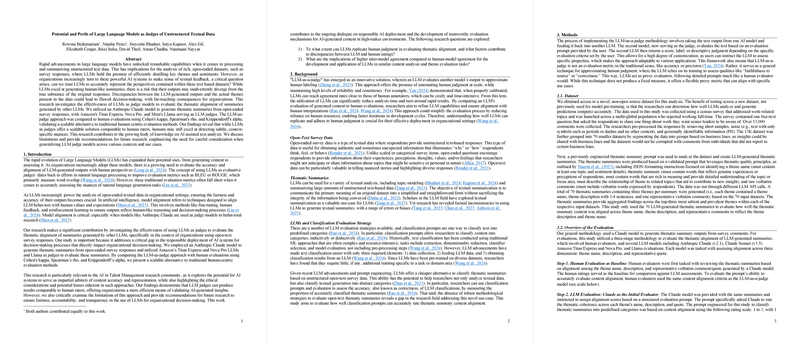Critical Evaluation of LLMs as Judges in Thematic Content Analysis
The paper "Potential and Perils of LLMs as Judges of Unstructured Textual Data" meticulously explores the evolving role of LLMs in evaluating thematic summaries derived from unstructured textual data, with a specific emphasis on open-ended survey responses. The research hinges on a dual approach, assessing the efficacy of LLM-generated thematic evaluations against human judgments, thereby probing the alignment of AI-generated outputs with human perspectives. This investigation is pivotal, given the integration of LLMs in organizational decision-making processes.
Methodological Approach
The paper employs an Anthropic Claude model to generate thematic summaries from an extensive dataset derived from open-ended survey responses. Top-tier models from Amazon and Meta, specifically Titan Express, Nova Pro, and Llama, serve as evaluative judges for these summaries. The methodology is underpinned by comparative analysis using established statistical metrics, including Cohen's kappa, Spearman's rho, and Krippendorff's alpha. This methodological framework offers a scalable alternative to traditional, human-centric evaluations while acknowledging potential subtle nuances that human evaluators may detect more effectively than LLMs.
The dataset comprises over 13,000 comments, facilitating the generation of 70 thematic summaries. A rigorous human evaluation benchmark is established, serving as a baseline against which the LLM outputs are assessed. The LLM models are tested for their ability to replicate human judgments in thematic alignment, focusing on three critical aspects: theme name, description, and representative quote.
Results and Analysis
The paper indicates that LLMs, serving as judges, can offer a scalable, efficient means of evaluating text summaries, exhibiting a moderate to substantial agreement with human raters. Notably, the Sonnet 3.5 model exhibits a Cohen's kappa score of 0.44, the highest in terms of human-model alignment. However, when considering inter-model consistency, these models display even higher agreement, suggesting a robust intra-ai alignment.
Despite the promising inter-model agreement, the reported Cohen's kappa between LLMs and human judges indicates that there are discrepancies rooted in the LLMs' limitations in fully capturing nuanced thematic details, which often require a more nuanced human understanding. This discrepancy underscores the persistent necessity for human oversight in AI-led evaluation processes.
Implications for Future Research
The research presents crucial insights into the capabilities and limitations of LLMs in thematic analysis, emphasizing the importance of integrating additional evaluation metrics to address observed biases, such as position and verbosity bias. The paper suggests the need for a multi-disciplinary approach in developing comprehensive success metrics for AI tools, incorporating insights from computer science, linguistics, psychology, and domain experts to enhance alignment with human judgments.
Despite the inherent challenges, the potential benefits of using LLMs in content analysis—such as reduced time and resource demands—invite further exploration and refinement of these models. Future research is encouraged to explore more sophisticated prompt engineering and evaluation criteria, aiming to enhance LLM alignment with human judgment, accounting for thematic salience and contextual factors.
Conclusion
The paper offers a nuanced analysis of the evolving role of LLMs as judges in thematic content evaluation, providing a critical assessment of their current capabilities and inherent limitations. It further underlines the necessity for continuous improvement of both LLM models and evaluation frameworks to achieve higher fidelity in AI-human alignment, ultimately contributing to more informed and reliable organizational decision-making processes. The work stands as a valuable contribution to the ongoing discourse on responsible and ethical AI deployment in the analysis of unstructured textual data.
